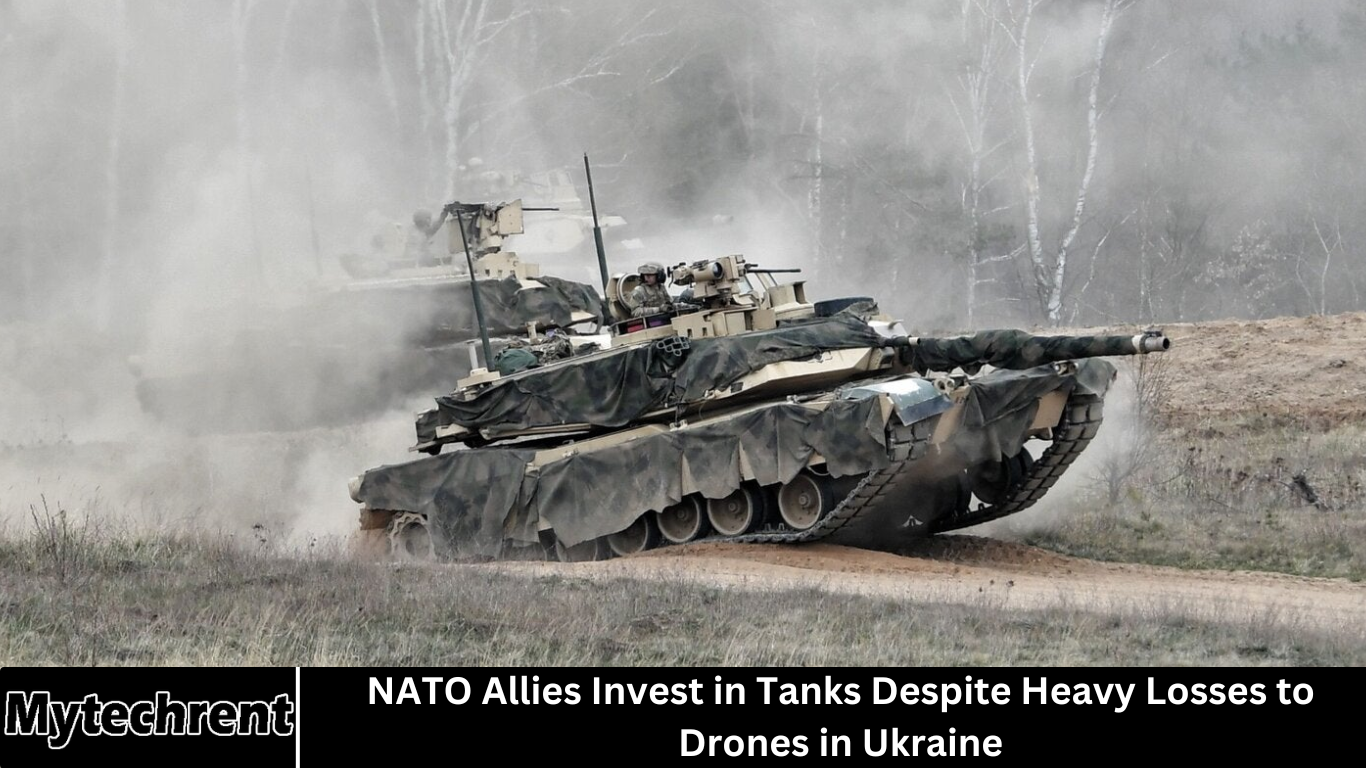Despite the dramatic shift in modern warfare marked by the rise of drone technology, NATO allies continue to pour billions into the development and procurement of main battle tanks.
- 1. The Changing Face of Modern Warfare
- 2. Drone Warfare in Ukraine: A Game Changer
- 3. Tank Vulnerability: Lessons from the Frontlines
- 4. Why NATO Still Invests in Tanks
- 5. The Evolution of Tank Design
- 6. Balancing Forces: Drones and Armor Working Together
- 7. Geopolitical Considerations
- 8. The Industrial and Political Drivers
- 9. Criticisms and Counterarguments
- Frequently Asked Question
- Why are NATO allies still investing in tanks despite their vulnerability to drones?
- How have drones affected tank warfare in Ukraine?
- Are modern tanks being redesigned to counter drones?
- Is the tank becoming obsolete in modern warfare?
- What countries in NATO are increasing their tank investments?
- How are tanks and drones being used together on the battlefield?
- What are the main criticisms of NATO’s tank investments?
- Conclusion
The war in Ukraine, often referred to as a testing ground for next-generation weapons, has laid bare the vulnerabilities of tanks to low-cost, highly maneuverable drones.
Yet, military powers like the United States, Germany, Poland, and the UK remain committed to strengthening their armored ground forces.
More Read: Apple Removes ICE Tracking Apps Following Pressure from Bondi’s DOJ
1. The Changing Face of Modern Warfare
Modern conflict has rapidly evolved from conventional, symmetrical warfare to battles dominated by asymmetrical tactics and advanced technologies.
Drones, cyber warfare, and AI-enabled targeting systems are now standard tools in a nation’s arsenal. The Russia-Ukraine war has particularly highlighted how smaller, agile, and inexpensive tools like FPV (First Person View) drones can inflict damage far beyond their cost.
Yet, despite this shift, NATO remains committed to upgrading and expanding its tank fleets—an apparent contradiction in modern military doctrine.
2. Drone Warfare in Ukraine: A Game Changer
The war in Ukraine has demonstrated the devastating effectiveness of drones in destroying expensive armored vehicles, including:
-
Russian T-72 and T-90 tanks targeted by commercial drones rigged with explosives.
-
Ukrainian tanks ambushed using Lancet loitering munitions and suicide drones.
-
Precision strikes coordinated using real-time video feeds and GPS signals.
Key stats:
-
Over 3,000 tanks and armored vehicles have reportedly been destroyed or disabled in Ukraine.
-
FPV drones costing under $1,000 have destroyed tanks worth millions.
These developments have caused many to question the continued viability of heavy armor in future conflicts.
3. Tank Vulnerability: Lessons from the Frontlines
Tanks were traditionally designed to withstand heavy artillery, RPGs, and anti-tank missiles. However, drones have changed the calculus. They offer:
-
High maneuverability, avoiding traditional countermeasures.
-
Low radar profiles, making detection difficult.
-
The ability to strike from above, where tanks are weakest.
Even advanced tanks like the German Leopard 2 and American Abrams M1A2 have shown vulnerabilities when not paired with proper drone defense systems.
4. Why NATO Still Invests in Tanks
Despite these vulnerabilities, NATO countries are doubling down on tank production and modernization.
Reasons include:
Tanks Still Dominate Ground Warfare
Tanks provide unmatched firepower, protection, and psychological impact on the battlefield. When supported by infantry, artillery, and air power, they remain crucial for holding and taking territory.
Combined Arms Doctrine
Modern military strategy still relies on a combined arms approach, where tanks work in coordination with other forces. This doctrine isn’t obsolete—just evolving.
Upgrades and Countermeasures
New tank models are being equipped with:
-
Active Protection Systems (APS) like Israel’s Trophy system.
-
AI-enabled threat detection.
-
Drone jamming technology and hard-kill systems.
These upgrades are designed to neutralize the drone threat and ensure tanks remain viable.
Strategic Deterrence
Heavy armor is a symbol of power and deterrence. Countries on NATO’s eastern flank—like Poland and the Baltics—see tanks as essential to counter potential aggression from Russia.
5. The Evolution of Tank Design
To adapt to the new threats, NATO members are investing in next-generation tanks.
Key projects include:
-
Germany’s Panther KF51 by Rheinmetall: Boasts drone defense, AI, and modular weapons.
-
U.S. M1A3 Abrams upgrade: Lighter, faster, with integrated APS and hybrid power.
-
France-Germany Main Ground Combat System (MGCS): Set to replace Leopard 2 and Leclerc tanks in the 2030s, combining manned and unmanned systems.
These advancements focus on flexibility, survivability, and integration with digital warfare systems.
6. Balancing Forces: Drones and Armor Working Together
Rather than seeing tanks and drones as mutually exclusive, NATO strategists envision them as complementary assets.
-
Drones can scout ahead of tank columns, identifying threats.
-
Tanks provide firepower and shock value that drones can’t match.
-
Swarming drone tactics can be neutralized by electronic warfare units attached to armored divisions.
The future battlefield will likely see tanks and drones operating in tandem, not in competition.
7. Geopolitical Considerations
NATO’s investment in tanks is also driven by geopolitical necessity.
-
Eastern European nations, especially Poland, are rapidly expanding their tank fleets in response to Russian aggression.
-
Finland and Sweden, new NATO members, are integrating Western armor to align with alliance standards.
-
The U.S. military industrial complex plays a significant role in promoting armored vehicle production as part of its global defense strategy.
8. The Industrial and Political Drivers
Defense Contracts and Jobs
The tank industry supports thousands of jobs and generates billions in revenue. Governments are under pressure to protect domestic defense sectors, even if the battlefield effectiveness of tanks is questioned.
Long Procurement Cycles
Tanks are often ordered years in advance. Much of NATO’s recent investment was already in the pipeline before the full impact of drone warfare was known.
Interoperability and NATO Doctrine
NATO operations rely on standardized platforms. Tanks remain key assets in joint missions, and interoperability is critical for alliance cohesion.
9. Criticisms and Counterarguments
Despite these arguments, many military analysts remain skeptical of NATO’s tank-heavy investments.
Common criticisms:
-
“Tanks are outdated and too expensive”: Critics argue the cost-to-benefit ratio is too high, especially when drones offer greater agility and cost-effectiveness.
-
“Defense spending is being misallocated”: More emphasis should be placed on electronic warfare, drone development, and AI.
-
“Tanks can’t survive in urban warfare or contested airspace”: They require complete air superiority, which isn’t guaranteed in future wars.
Frequently Asked Question
Why are NATO allies still investing in tanks despite their vulnerability to drones?
NATO allies view tanks as essential components of combined arms warfare, offering heavy firepower, mobility, and protection. Despite drone threats, tanks are being upgraded with active protection systems, drone jammers, and AI-enhanced defense to adapt to modern threats. They remain vital for holding territory, deterring aggression, and supporting ground forces.
How have drones affected tank warfare in Ukraine?
Drones have drastically changed the battlefield in Ukraine, enabling low-cost, high-precision attacks on expensive armored vehicles. First-person view (FPV) drones and loitering munitions have destroyed hundreds of tanks by exploiting weak points in armor, particularly from above. This has forced militaries to rethink tank deployment and protection strategies.
Are modern tanks being redesigned to counter drones?
Yes. Modern tanks are being equipped with systems like Active Protection Systems (APS), radar-based threat detection, and electronic countermeasures to detect and destroy incoming drones or missiles. Future tanks, such as the German KF51 Panther and upgraded M1 Abrams, are designed to better withstand drone threats through improved sensors, armor, and AI integration.
Is the tank becoming obsolete in modern warfare?
Not yet. While tanks face growing threats from drones and other precision weapons, they are still seen as irreplaceable for certain battlefield roles—especially in large-scale, high-intensity conflicts. The future of tanks likely lies in their ability to operate as part of a networked, multi-domain force rather than as standalone weapons.
What countries in NATO are increasing their tank investments?
Several NATO countries are boosting their armored capabilities, including:
- Poland, which is purchasing U.S. Abrams and South Korean K2 tanks.
- Germany, developing the next-generation KF51 Panther.
- United States, investing in upgraded Abrams platforms.
- UK, modernizing its Challenger 3 fleet.
- These investments are seen as a deterrent against potential Russian aggression and a commitment to NATO’s defense posture.
How are tanks and drones being used together on the battlefield?
Rather than replacing tanks, drones are increasingly used alongside them. Drones provide real-time reconnaissance, spot targets for tanks, and carry out strikes on enemy positions. Tanks, in turn, offer heavy firepower and can act as command nodes in a networked force. The combination enhances battlefield awareness and response time.
What are the main criticisms of NATO’s tank investments?
Critics argue that tanks are too expensive, vulnerable, and slow to adapt to new threats like drones. They believe military spending should shift toward drones, cyber warfare, AI, and electronic warfare. Some also point out that tanks are ineffective in urban or highly contested environments without air superiority or proper infantry support.
Conclusion
NATO’s continued investment in tanks amid widespread drone losses in Ukraine highlights a broader tension between tradition and innovation in military planning.
While drones have clearly reshaped the battlefield, tanks are evolving—not disappearing. Their role is being redefined in a combined, tech-driven warfare ecosystem. For now, NATO is betting that better-protected, smarter, and more connected tanks will still have a place in 21st-century conflict.








